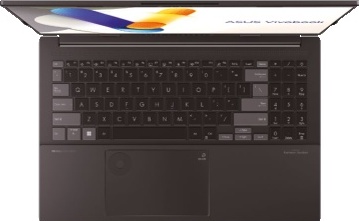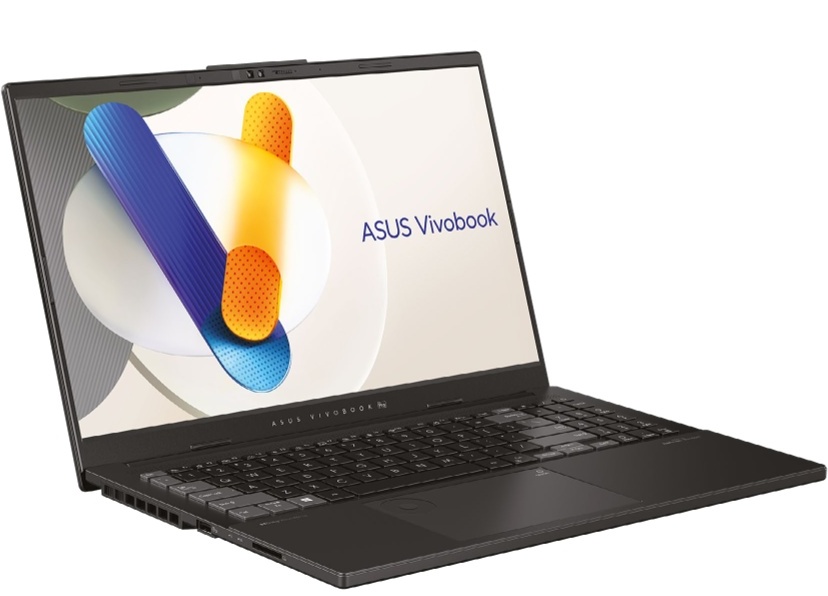This review first appeared in issue 357 of PC Pro.
This year’s update to Asus’ Vivobook Pro 15 makes one thing obvious: the days when you had to pay over £2,000 for a powerful mobile workstation are gone. Packed inside this 1.8kg monster you’ll find Intel’s top-end Core Ultra 9 185H processor and GeForce RTX 4060 graphics, and with Nvidia’s Studio software it’s ready to go with a bunch of professional apps.
Asus certainly has its eye on designers here, even building a dial into the top left of the touchpad. If you’re dexterous enough to keep within its 3cm diameter then you can use it to whizz through timelines in Premiere Pro, adjust brush sizes in Photoshop and switch font sizes in PowerPoint. It’s no replacement for a hardware dial, but could be a time-saver on the move.

The Pantone-validated OLED display is another plus point. Not merely because it’s incredibly sharp, thanks to 2,880 x 1,620 pixels across a 15.6in diagonal, but also because it ships with presets for sRGB, DCI-P3 and Display P3. Or you can stick with its native color gamut, which covers 99% of the DCI-P3 space (with a 115% volume) and reproduces colors with near-perfect accuracy. It hit a respectable 387cd/m2 in SDR mode, and with VESA DisplayHDR True Black 600 certification it should be no surprise that films look incredible.
There’s a fine pair of speakers here, too, with vocals coming through with particular clarity. That quality extends to the 1440p webcam. If you find, as I did, that the captured audio isn’t as clear as you hoped, head into the settings within the MyAsus app and switch off all the AI enhancements.

This app is also where you’ll find the color gamut options and control over the fan settings. I don’t see the point of buying a laptop as powerful as this and not putting those fans into Performance mode; they’re noisier, but you’re rewarded with significantly faster frame rates in games: Metro Exodus Enhanced’s averages went up by over 10%, for instance, moving from 61fps at 1080p High settings to 68fps. And 3DMark Time Spy jumped from 7,969 to 8,605.
If you buy this laptop then you’ll get faster results still, as the system Asus sent me had RTX 4050 graphics rather than RTX 4060. As mentioned in the HP Omen Transcend review, you’ll struggle to get above 120fps to take advantage of the screen’s 120Hz refresh rate in most games – I only breached 100fps in Cyberpunk 2077 at 1080p medium and Shadow of the Tomb Raider at 1080p High – but all current AAA games will play fluidly at reduced settings.

Our test machine came with a Core 7 Ultra, but shipping units include the Core Ultra 9 185H. With Asus providing combined CPU and GPU power of 125W it will never feel sluggish. The thick – by modern standards – chassis also has plenty of room for a chunky heatsink and fans, but the drawback is battery life. It lasted for 8hrs 19mins in PCMark’s video-rundown test, but switching to Modern Office dropped that to 5hrs 59mins. You’ll need to take the meaty 200W power supply with you.
This has its own power socket, which sits on the right-hand side of the chassis along with Thunderbolt 4, USB-C and USB-A ports. And a gigabit Ethernet connector, 3.5mm jack and HDMI 2.1 output. Safe to say it’s crowded. A single USB-A port and SD card reader sit on the left, along with the heat exhaust vents.

With a crisp keyboard, complete with number pad, this is a laptop computer that has appeal across the spectrum. I can see reasons for writers, gamers, designers and video editors to reach for their wallets.

